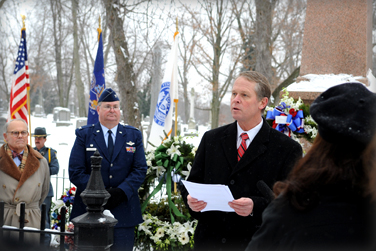News
Fillmore fans carry on a tradition

James A. “Beau” Willis, executive vice president for university support services, delivers remarks at the Fillmore gravesite in Forest Lawn. Photo: NANCY J. PARISI
A light snow began to fall shortly after 10 a.m. today, dusting the coats of the men and women gathered in a semi-circle by the black gates of the Fillmore family plot at Forest Lawn Cemetery and Crematory in Buffalo. It was a curious sight, this crowd—these people swaddled in scarves and winter-wear, trying to keep warm as they stood on a blanket of white snow between the graves.
It was cold, a day of frozen fingers and toes, with a temperature in the 20s. But this was not a time for complaining. The mood, despite the heavy chill, was upbeat.
“This is not bad at all,” one onlooker said. “Actually, one of the better years.”
Call them crazy, but these spirited souls had convened for a purpose—to carry on the decades-old tradition of celebrating the birthday and life of Millard Fillmore, America’s 13th president, UB’s first chancellor, and a proud Buffalonian.
Jan. 7, 2010 marked the 210th anniversary of Fillmore’s birth and the 45th year of UB’s stewardship of the annual service in his honor.
The event, with all its quirks and idiosyncrasies, was one about remembering history and the achievements of those who contributed to building Western New York. Fillmore was one of the region’s great civic leaders, helping to establish Buffalo General Hospital, the Buffalo Historical Society, the Buffalo Savings Bank and the city library system. He served as UB chancellor from 1847 until his death in 1874. He was United States president from 1850 to 1853, the last Whig Party member to hold that office.
“It’s not just some hokey thing,” said Marc Adler, an adjunct professor in UB’s Millard Fillmore College and immediate past president of the UB Alumni Association. “A lot of different people show up,” he pointed out. “It’s not just you, me and Millard.”
The commemoration opened with a presentation of flags by the UB Police Color Guard a welcome by William Regan, the university’s special events director, and a moment of silence for UB’s 13th president, William R. Greiner, who died Dec. 19.
Following an invocation, Adler and representatives of The Buffalo Club and Forest Lawn presented wreaths, along with Col. Timothy Vaughn, commander of the New York Air National Guard’s 107th Mission Support Group, who paid tribute on behalf of the White House. The largest garland was several feet wide, with red carnations, white lilies and blue-hued irises woven into the branches. The script on a plain white note card adorning the ornament said simply, “The President.”
James A. “Beau” Willis, executive vice president for university support services, delivered the memorial address. Willis, who moved to Western New York from California about six years ago, said he had little appreciation for Buffalo’s rich history when he first arrived. Time has changed his perspective, he said.
“The occasion to speak today has given me the opportunity to understand Millard Fillmore not as a forgotten president...but as a broadly accomplished man of considerable foresight, deep conviction and steadfast perseverance—a man whose public life could be characterized as that of constructive and noble statesmanship and whose private life can be regarded as that of model citizenship,” said Willis, who wore a long black coat, red tie and white collared shirt.
He then told spectators that Fillmore’s legacy lay not only in his accomplishments, but in lessons to be learned from the way he lived—in his strength of conviction, in his commitment to public service. Today, Willis suggested, these are the qualities that will help Western New York move forward and recover from the collapse of industry in the region.
“Despite its distinguished past, its laudable institutions and its enterprising and hardworking people, we find ourselves as a community struggling to find relevance in today’s world,” Willis said. “The challenges before us—be they economic, social or political—need not be enumerated on an occasion such as this, but they are daunting and, for most, seem insurmountable. But I would suggest that though different, these challenges are no less formidable than those that confronted Millard Fillmore’s generation at the time of his birth 210 years ago.”
Willis ended his speech to applause muted only by his listeners’ gloved hands. “That was very good,” one woman whispered to a companion.
The ceremony closed with the playing of “Taps” by West Richter, an undergraduate student and member of UB’s marching band. The final note of the solemn song seemed to linger in the air as the crowd began to disperse, leaving behind the wreaths and their footprints in the clean, white snow.

Reader Comments